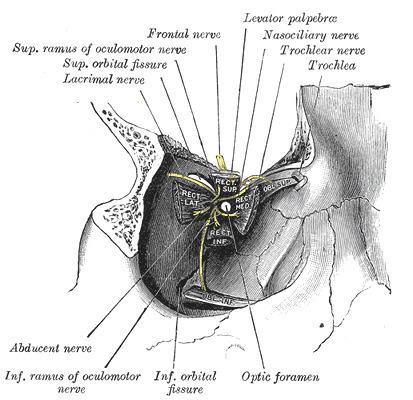From ophthalmic nerve Latin nervus lacrimalis TA A14.2.01.018 | Dorlands/Elsevier n_05/12566040 FMA 52628 | |
 | ||
The lacrimal nerve is the smallest of the three branches of the ophthalmic division of the trigeminal nerve.
It sometimes receives a filament from the trochlear nerve that is derived from the branch that goes from the ophthalmic to the trochlear nerve.
It passes forward in a separate tube of dura mater, and enters the orbit through the narrowest part of the superior orbital fissure.
In the orbit it runs along the upper border of the lateral rectus, with the lacrimal artery, and communicates with the zygomatic nerve, a branch of the maxillary nerve.
It enters the lacrimal gland and gives off several filaments, which supply sensory innervation to the gland and the conjunctiva.
Then, it pierces the orbital septum, and ends in the skin of the upper eyelid, joining with filaments of the facial nerve.
The lacrimal nerve is occasionally absent, and its place is then taken by the zygomaticotemporal branch of the maxillary nerve. Sometimes the latter branch is absent, and a continuation of the lacrimal nerve is substituted for it.
Functions
It provides sensory innervations for the lacrimal gland, conjunctiva, and the lateral upper eyelids.
The zygomatic nerve carries sensory fibers from the skin and mucous membranes. It also carries post-synaptic parasympathetic fibers (originating in the pterygopalatine ganglion) to the lacrimal nerve via a communication. These fibers will eventually provide innervation to the lacrimal gland.
